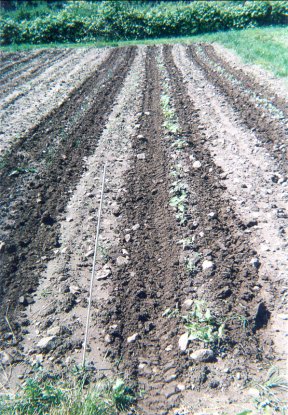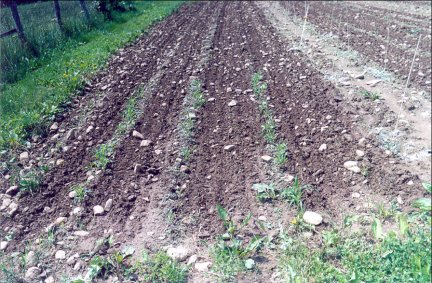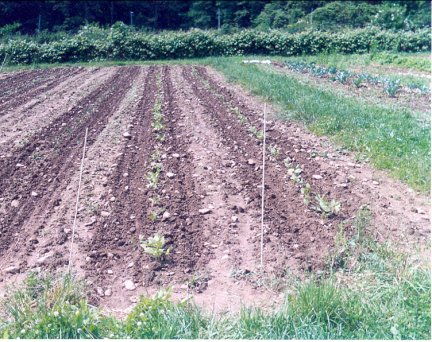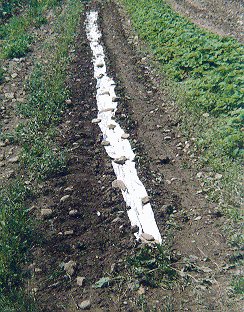|
SITE
INDEX
QUICKENING
NEWS
PREPARATIONS
1.
Food
2.
Manna
Meals
3.
Water
4.
Sanitation
5.
Medical,
health
6.
Kerosene heaters and cookers
7.
Lighting
8. Wood
cooking and heating
9. Communi-cations
10. Essential
Tools
11. Home
built items
12.
Electrical; generators
and power
13. War
preparedness
14.
Gardening
SITE
INDEX
Miles Stair's SURVIVAL
SHOP
HOME
RADIATION
INDEX & JET STREAM
PROPHECY
COMMENTARY
BY MILES
BOOKLETS
BY MILES
GUEST
SUBMISSIONS
PHOTO
INDEX
LINKS
SITE
INDEX
Miles Stair's
SURVIVAL
SHOP
|
|
|

|
Here is another view of the
beans and a row of onion sets which have just
been cultivated. The undisturbed soil between
the cultivated rows has been planted with
narrow crops which are not yet visible. As soon
as they are up, they will be cultivated too. I
use the white fiberglass posts to mark all rows
and hills until they can be clearly seen. |
|
This young
corn has also just been cultivated by the
tractor. There is very little left to be done
by hand, only the larger weeds between the corn
plants need to be pulled. On the right hand
side of this photograph, you can see young
hills of squash, pumpkins and cucumbers. With a
narrow furrower, I made two rows just over 30
inches apart, and staggered hills along them.
Each hill was marked with a fiberglass post.
With a full width cultivator on the tractor, I
was able to drive along the outer sides of the
two rows, and make a gentle "S" shaped path
between them. Later they will be mulched to
keep in the moisture, and choke out any
weeds. |
 |
|

|
Here are two
rows of young beans which have been cultivated
by driving over, or straddling them with one of
my small modified riding tractors. Because
beans need more space when full grown, and we
need room to pick them, I have planted the
adjacent rows with narrow crops like onions,
carrots and beets. They are not up well enough
to see them clearly, so those rows are marked
by the white 3/8 inch diameter fiberglass posts
sold for temporary electric fences. It is about
24 inches from the center of one row to the
center of the next. With the 30 inch wide
riding tractor, I simply overlap the tire
tracks in the paths. |
Cabbage is a very important crop,
with high yields of food. It can be eaten raw as Cole
Slaw, boiled alone or with carrots, potatoes and ham,
stir fried for a nutty flavor, or fermented into sour
kraut. It also keeps for months in a root cellar, or it
may be canned or dried for indefinite storage. The Fall
or Winter varieties are the best keepers.
In the South, or coastal areas, you
maybe able to grow cabbage over the Winter. Here where
I live, we have to start Spring cabbage and broccoli
inside, and set out the plants. The Winter keeping
varieties are the important ones, and here is how we
start ours in the early Summer. We add manure or
fertilizer and deeply work the soil with a single tine,
only under the row itself. Then we wet the row
thoroughly, and plant the seed shallowly.
|

|
We try to space the seeds
out, but it is easy to move the plants later,
just before a rain. Then we cover
the row with strips of cloth, as from old bed
sheets, and weigh that down with rocks. The
cabbage will be up as strong plants in only
three days, and you remove the cloth. Once the
plants are a few inches tall, it's time to move
any that are too close together. If you don't
have a thorough rain right after you
transplant, water them very well daily for
three days. |
Continued at Garden Tractor
Gardening, Part III
GARDENING ARTICLES by New England Gardener
-
Site
Index
|
|
|




